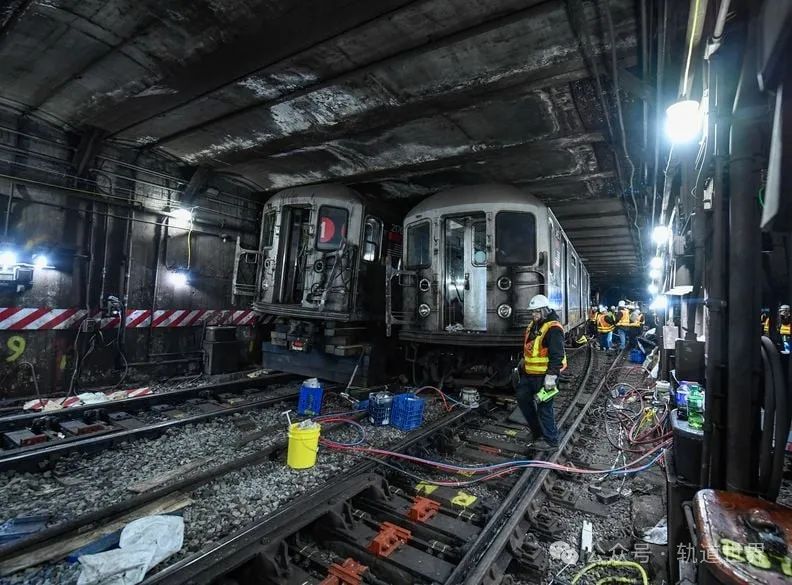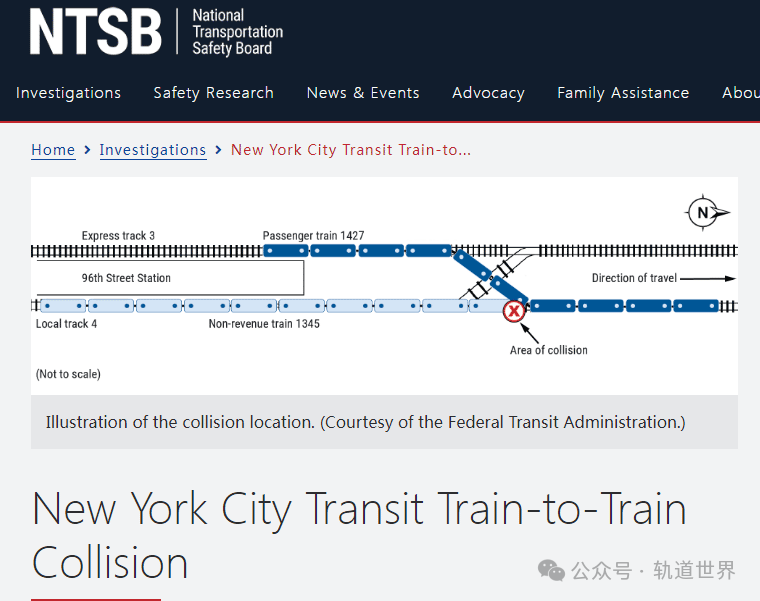
美国国家运输安全委员会(NTSB)25日发布对于今年年初曼哈顿地铁列车相撞脱轨事故的初步调查报告。报告证实,有乘客违规按下列车的紧急制动装置后无法复位是造成事故的前因,而故障列车在通信不畅的条件下行驶则是导致撞车的直接原因。
今年1月4日,地铁1号线的两组列车在曼哈顿上城的96街车站附近的隧道内发生低速碰撞,导致22名乘客和3名地铁驾驶员受伤、列车车厢脱轨,事故还造成地铁1/2/3线曼哈顿段落中断运营近3天。
事发后,联邦交通委员会联合大都会运输署(MTA)、联邦运输部(Federal Transit Administration)、纽约市交通局(New York City Transit)等机构开展联合调查。

调查发现,当日下午2时许,一名“手欠”的乘客贸然拉动了1345号列车上的紧急刹车按钮导致异常停车,在驾驶员发现紧急制动导致的情况无法现场复位后,只能清空列车并继续向北驶往检修场。1345号列车驾驶员的证词表示,由于发生故障的前五节车厢必须切断供电才能解锁制动系统,因此当时只能由一名驾驶员在车头充当观察员,指挥后半部的驾驶员开动列车。然而,当列车驶出96街站后,观察员看到了前方的停止信号,却发现无线电通信系统失灵,导致后方驾驶员无法收到指令,因而列车闯过了红灯,撞上了另一列正在通过道岔从快行线转入慢行线的载客列车。报告还指出,虽然在事发道岔信号灯处安装有「自动停车」(trip-stop)设备以防止列车闯红灯,但由于肇事列车的前五节车厢已被切断了刹车系统,因此trip-stop设备也失效。
国家运输安全委员会介绍,目前调查还在进行中,本版报告仅还原了事故发生前和发生时的经过,而未来的调查重点将在于地铁调度人员在移动损坏车辆时的操作程序、无线电通信程度等内容是否合规,并确定在多重安全防护的操作中应付责任。
根据此前的报导,纽约地铁紧急制动装置遭破坏的事件并非偶发。2023年,整个地铁系统共发生了1748次紧急刹车,造成7365个车次延误。而根据事后调查,其中仅有30次是确有发生紧急情况需要停车。
New York City Transit Train-to-Train Collision
What Happened
This information is preliminary and subject to change. Release date: 25 January 2024
On January 4, 2024, about 3:00 p.m., northbound New York City Transit (NYCT) non-revenue train 1345 collided with northbound passenger train 1427 on the Number 1 Line north of 96th Street Station in Manhattan, New York. Train 1427 was crossing over from express track 3 to local track 4 when train 1345 overran a red signal at the north end of the station platform, entered the crossover, and struck the fifth railcar of train 1427. Train 1345 derailed two railcars and train 1427 derailed three railcars. About 22 passengers and 3 crew members suffered minor injuries. At the time of this report, NYCT had not estimated the cost of damages. The collision occurred in the underground subway system, so weather was not a factor.
Passenger train 1427 comprised 10 railcars and its crew consisted of a conductor and an operator. The train was carrying about 200 passengers at the time of the collision. Train 1345 was also a 10-railcar train, and its crew consisted of a transit system supervisor, an operator (who was acting as a flagger), a conductor, and a railcar inspector.
Before the collision, about 2:11 p.m., an unruly passenger aboard train 1345 triggered an emergency braking application by pulling the emergency brake valve cords on the first five railcars.These emergency brake valve cords are accessible to passengers within each railcar. After the operator of train 1345 was unable to reset the emergency braking application, the operator moved the train to 79th Street Station and offloaded all passengers. A railcar inspector with NYCT arrived on scene but was also unable to reset the brakes, placing the train into bad order (out-of-service) status.
The operations control center instructed the railcar inspector to cut out the brakes and traction motors on the five railcars in the front portion of the train so it could be operated. The inspector was then instructed to move the out-of-service train to a rail yard for repairs. After the railcar inspector performed the cut out, train 1345 departed 79th Street Station at restricted speed, northbound on track 4 toward 96th Street Station, destined for a nearby yard.6 The transit system supervisor was operating the controls of the sixth railcar. The flagger was positioned in the lead railcar and communicating with the transit system supervisor to coordinate the train’s movements. In interviews with National Transportation Safety Board investigators, the flagger said he lost radio communications with the transit system supervisor near 96th Street Station. The transit system supervisor did not receive the flagger’s instruction to stop, the train passed by a signal requiring a stop at the end of the 96th Street Station platform, and the collision occurred. The track in the area was equipped with trip-stops, which activate a train’s emergency brakes if the train passes through a signal requiring a stop. Because the brakes on the first five railcars had been cut out, emergency brakes could not be activated by the trip-stop.
While on scene, National Transportation Safety Board investigators requested security camera images and radio audio recordings; reviewed signal logs; reviewed? NYCT operating procedures; conducted sight distance observations; inspected both trains and tested the brakes on the last five railcars of train 1345; tested the portable radios used by the crew of train 1345; and completed interviews. Neither train was equipped with event recorders, cameras, or other recording devices. ??
The National Transportation Safety Board’s investigation is ongoing. Future investigative activity will focus on NYCT’s operating procedures when moving bad order cars, radio communication procedures, mechanical procedures when placing a revenue train in bad order status, and the lack of federal requirements for railcar event recorders on FTA regulated properties.